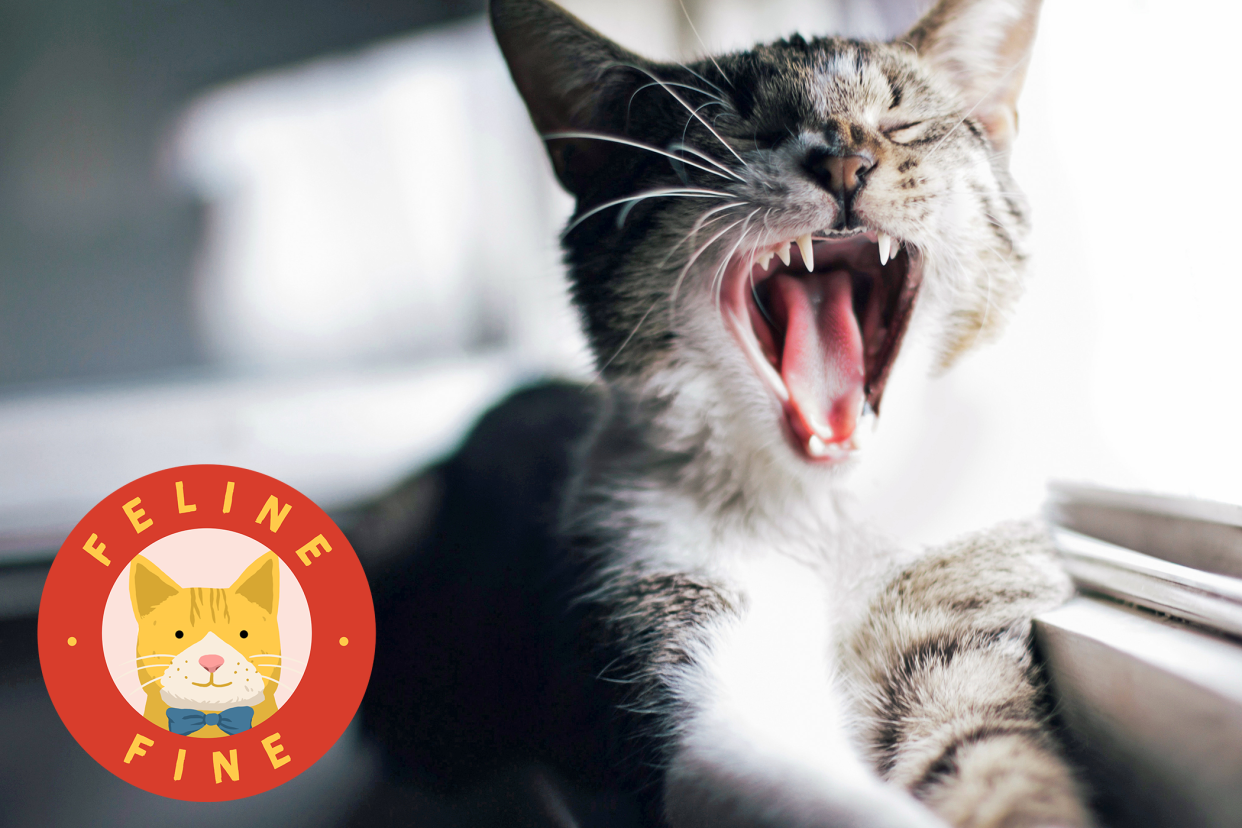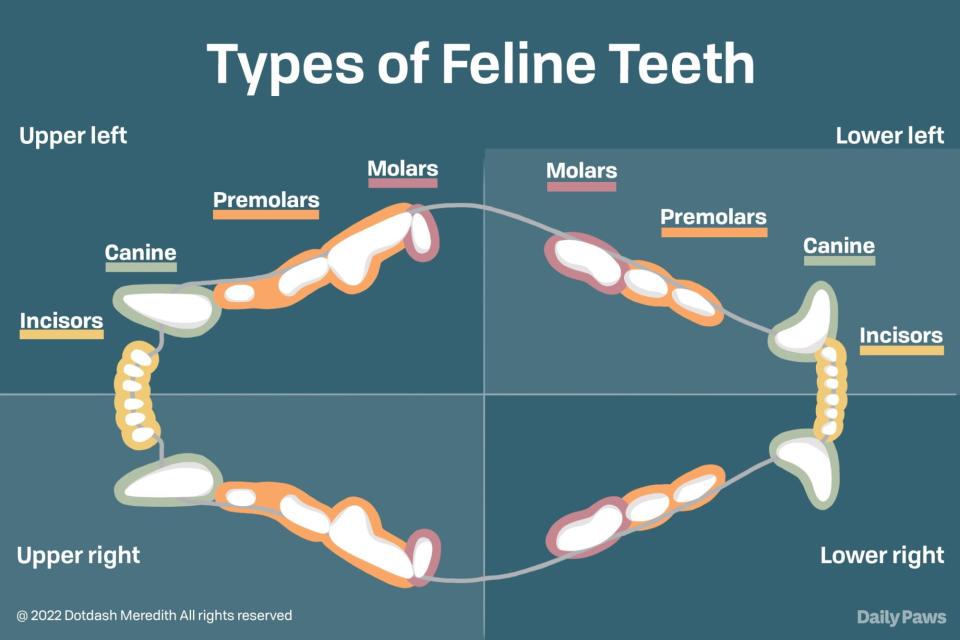How Many Teeth Do Cats Have? Here's What the Kitty Dentist Says

disq / Adobe Stock
TABLE OF CONTENTS
On This Page
Types of Cat Teeth
Kitten Teeth
Adult Teeth
How to Keep Your Cat's Teeth Healthy
It might be a stretch to think of your happy house cat as a fierce huntress. But peek into her mouth and her wild roots might be more obvious. Her little mouth is full of teeth—some razor-sharp for tearing into prey, others a little daintier. Like us, cats have different types of teeth and each plays a different role in survival.
If you're wondering how many teeth do cats have and their functions, we have the answer—plus, pointers on how to keep those pearly whites sharp.
Types of Cat Teeth
The number of teeth cats, humans, and pups have differs—but we all share the same type of teeth. Humans have a combination of sharp and flat-surfaced teeth for grinding. Cats' teeth retain a sharp edge, fit for their diet as obligate carnivores. Here's what they are and how they work in cats.
Incisors
These are the little teeth in the front of a cat's mouth. They're typically used for snipping—like when your cat is grazing on cat grass.
Canine teeth
Right behind the incisors are the big fangs called canines. They sometimes peek out when a cat is resting. "They are long, strong teeth used to bite into and grasp another animal's flesh—either when hunting or defending themselves," explains Shanna Landy, DVM, a dentistry and oral surgery resident at the Cornell University Hospital for Animals.
Pre-Molars
On either side of the jaw are wide teeth known as pre-molars. Your cat uses these pearly whites to grasp and bite prey—or chow down on kibble. Adults and kittens have one fewer pre-molar on either side of the bottom jaw.
Molars
These teeth sit behind the pre-molars on the top and bottom jaw. They're smaller than pre-molars and help crunch kibble and other hard foods.

Corinne Mucha
How Many Teeth Do Kittens Have When They're Born?
Technically speaking, how old a kitten is when they develop teeth comes down to what you consider to be teeth, Landy says. The tissues organize and create rudimentary tooth buds before a kitten is even born.
But kittens aren't born with any teeth above the gum line. It's not until 2 or 3 weeks of age that a kitten's teeth emerge—a biological delay Mama Cat is sure to appreciate.
Like human babies, a kitten has fewer teeth than an adult cat:
12 incisors
4 canines
10 pre-molars
That adds up to 26 kitten teeth total, called deciduous teeth. "Yep, that's 'deciduous' just like trees that lose their leaves every year since these teeth fall out after such a short time," says Jo Meyers, DVM at Vetster.
When Do Kittens Start Losing Their Baby Teeth?
How short is a short time for these baby teeth? "Normally, all of a kitten's baby teeth will have grown in by the time they are 3 to 6 weeks old," Landy says. Just six weeks later (around 3 to 4 months old) kittens start losing their teeth—beginning in the back of the mouth with the premolars and moving forward to the canines. Lastly, they'll lose their baby incisors.
RELATED: Signs Your Kitten Is Teething and What to Do
How Many Permanent Teeth Do Adult Cats Have?
By 6 months old, a kitten has typically lost all of their baby teeth and has replaced them with a full set of adult chompers. Unlike a kitten, an adult cat has molars. That brings the total number of permanent teeth in domestic cats to 30:
12 incisors
4 canines
10 pre-molars
4 molars
Believe it or not, a cat's little mouth has just two fewer teeth than a human's mouth. "This number is the same regardless of the cat's breed and whether they live in a home or are feral," Landy says. But, she adds, it's not uncommon for cats to have missing teeth due to disease, injury, or a unique genetic makeup.
How to Keep Your Cat's Teeth Healthy
The most common disease in cats is periodontal disease—the inflammation of the gums (gingivitis) and the structures that keep the tooth in the socket. "If your cat has obvious signs of dental disease like red gums, brown tartar, missing teeth, or loose teeth, you'll know she's due for a cleaning," Meyers says. To prevent the onset of dental disease, it's best practice to regularly take your kitty to the vet for a teeth cleaning. Practicing dental hygiene at home can reduce the frequency of cleanings and make them less complicated, too.
The reality is, dental hygiene is really important. "Ignoring periodontal disease decreases a cat's life expectancy by as much as four to six years," Meyers says.
If you notice any pain or difficulty chewing food, dropping food, a change in texture preference, decreased appetite, or hissing or swatting at the food bowl, schedule a visit with your vet to see if there are any issues with your kitty's teeth.
Teeth Brushing
"The absolute best way to keep periodontal disease under control is with regular at-home tooth brushing," Landy says. This might sound daunting, especially since we just described the razor-sharp teeth domestic cats flaunt. With practice and positive reinforcement, it doesn't need to be as scary as it sounds (for you or your kitty). Plus, we have this handy guide on how to brush your cat's teeth.
Dental Treats
When it comes to dental treats and water additives, both experts agree that they're just not a substitution for routine brushing. "Think of it this way: Even if you were eating a special kind of treat, would you still feel okay about never brushing your teeth?" Meyers says.
Regular Check-ups
Whatever you and your feline friend can or cannot conquer at home, Meyers and Landy say routine dental checkups are a must. During regular veterinary exams, your vet will complete a visual inspection of your cat's mouth for plaque buildup and severe signs of disease.
Unfortunately, early signs of periodontal disease are below the gum line and are only spotted with an X-ray when your cat is under anesthesia. "If your cat is young, I recommend having their first anesthetized periodontal treatment done between 1 and 3 years of age," Landy says. "If your cat is older, have a discussion with your veterinarian on whether your cat is a safe candidate for general anesthesia and how to prioritize treating periodontal disease."
RELATED: Is Paying Your Vet Bills a Problem? Here's How to Find Help

